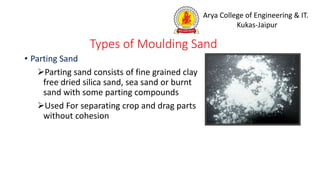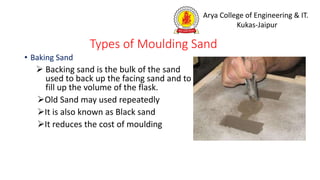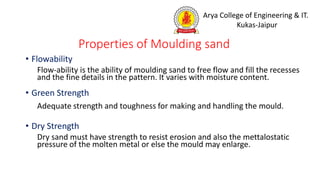Moulding sand Properties.pptx
- 1. Arya College of Engineering & IT. Kukas-Jaipur Unit ŌĆōI Manufacturing Processes Moulding sand Prepared By Nikil Kumar Khandelwal Department of Mechanical Engineering
- 2. Arya College of Engineering & IT. Kukas-Jaipur Moulding Sand Moulding sand is defined as granular particles resulting from the breakdown of rocks, due to the action of natural forces, such as frost, wind, rain, heat and water currents. Rocks have a complex composition and sand contains most of the elements of the rocks. Typical mixture of moulding sand contains 89% sand, 4% water and 7% clay
- 3. Arya College of Engineering & IT. Kukas-Jaipur Characteristic of Moulding Sand: ŌĆó Moulding sands are refractory in nature and can withstand temperature of metal being poured without fusing. ŌĆó The moulding sand do not chemically react with molten metal. ŌĆó The sand has high degree of permeability and thus allow gases formed during pouring to escape. ŌĆó These strength, permeability and hardness of the sand mix can be varied by changing the structure of sand.
- 4. Arya College of Engineering & IT. Kukas-Jaipur Types of Moulding Sand ŌĆó Natural Sand or Green Sand ’āś In Moist State ’āś 6-8 % Water ’āś 5-6 % Clay ’āś Having good Damping Capacity ’āś Used For Small and Medium Die casting
- 5. Arya College of Engineering & IT. Kukas-Jaipur Types of Moulding Sand ŌĆó Dry Sand ’āś Called as ŌĆ£Dry Sand MouldŌĆØ or Skin Dry Mould ’āśUsed For Large Casting ŌĆó Loam sand ’āś Contains 50 % Clay ’āśUsed For Heavy Casting ’āś Specially Used in Loam Mould
- 6. Arya College of Engineering & IT. Kukas-Jaipur Types of Moulding Sand ŌĆó Parting Sand ’āśParting sand consists of fine grained clay free dried silica sand, sea sand or burnt sand with some parting compounds ’āśUsed For separating crop and drag parts without cohesion
- 7. Arya College of Engineering & IT. Kukas-Jaipur Types of Moulding Sand ŌĆó Facing Sand ’āśIt is made of silica sand and clay without the addition of any used sand. ’āśThickness of the sand layer varies from 20 to 30 mm ’āśGraphite, mollasses etc. may be added to the facing sand. ’āśHigh strength and refractoriness are required for this sand.
- 8. Arya College of Engineering & IT. Kukas-Jaipur Types of Moulding Sand ŌĆó Baking Sand ’āś Backing sand is the bulk of the sand used to back up the facing sand and to fill up the volume of the flask. ’āśOld Sand may used repeatedly ’āśIt is also known as Black sand ’āśIt reduces the cost of moulding
- 9. Arya College of Engineering & IT. Kukas-Jaipur Types of Moulding Sand ŌĆó Core Sand ’āś Also Known as Oil sand ’āś This is silica sand mixed with core oil.
- 10. Arya College of Engineering & IT. Kukas-Jaipur Properties of Moulding sand ŌĆó Flowability Flow-ability is the ability of moulding sand to free flow and fill the recesses and the fine details in the pattern. It varies with moisture content. ŌĆó Green Strength Adequate strength and toughness for making and handling the mould. ŌĆó Dry Strength Dry sand must have strength to resist erosion and also the mettalostatic pressure of the molten metal or else the mould may enlarge.
- 11. Arya College of Engineering & IT. Kukas-Jaipur Properties of Moulding sand ŌĆó Hot Strength It is the strength of the sand above 212ŌŚ”F Capacity of sand to with stand hot metal mettalostatic pressure ŌĆó Porosity or Permeability It is the ability of the moulding sand to allow gasses to pass through. ŌĆó Refractoriness It is the ability of the sand to withstand high temperature with experiencing any physical changes
- 12. Arya College of Engineering & IT. Kukas-Jaipur Properties of Moulding sand ŌĆó Collapsibility Collapsibility is that property of the moulding sand which determines the readiness with which the moulding sand or mold ’āś Automatically gets collapsed after the casting solidifies ’āś Breaks Down in knock out and cleaning operations ŌĆó Adhesiveness The ability of the sand particles to get stick with another body is called adhesiveness.
- 13. Arya College of Engineering & IT. Kukas-Jaipur Properties of Moulding sand ŌĆó Bench life It is the ability of the moulding sand to retain its properties during storage or while standing ŌĆó Coefficient of Expansion Moulding sand should possess low Coefficient of Expansion ŌĆó Durability It is the capacity to withstand repeated cycles of heating and cooling during casting operation












